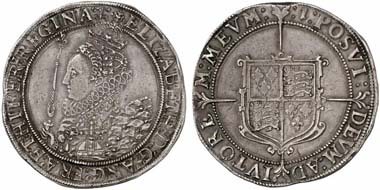by Björn Schöpe
courtesy of Barbara Balz / World Money Fair
She was the most eligible match of her time. Since her accession to the throne in 1558, it seemed logical that the young queen would marry. The nobles were pleased with the fact that the kingdom did not have a powerful sovereign; yet, they wished for a male heir to the throne to secure the future. But as Elizabeth received suitors and rejected proposals, the years passed by. Trying to make the most of her attitude, people proudly called her the Virgin Queen. Under the same name, she was to die at the age of 70. Before, though, she proved herself as an exceptionally gifted politician.
Elizabeth I (1558-1603). Crown, London, no year. (1601/2). Seaby 2582. From Künker auction 184 (2011), 5440.
After a short Catholic intermezzo that preceded her reign, Elizabeth reinforced the Protestant orientation of the Church of England. Thus, she found herself in opposition to the Catholic kingdoms in Europe. In 1493, the newly discovered world had been divided between the great powers Spain and Portugal. As long as England had been in alliance with other countries, her ships could go anywhere, but now she was forced to fight for free passage on the seas.
Ships were being built to travel the world and the seas. John Cabot went to explore North America, Walter Raleigh named a colony after his queen, Virginia, and brought tobacco and potatoes to Europe – although, at first, only tobacco was well received. Expeditions established new trade connections with Russia and Asia, and untiringly, British navigators were looking for the legendary Northwest Passage, a direct sea route to China north of the New World. And as England was isolated anyway, Elizabeth authorised courageous privateers to enforce the interests of the English Crown in the Caribbean and on all seas using the cannons of their ships.
The “Armada Portrait” of Elizabeth I. In the background the defeated Spanish Armada, the queen’s hand is resting on a globe reflecting her power over the entire world, c. 1588. By George Gower (1540-1596), today at Woburn Abbey. Source: Wikipedia.
The spirit of enterprise of the Protestant queen was not to the liking of the Catholic monarchies. In the year of 1588, the Spanish Armada, consisting of 50 heavily armed fighting ships and 80 smaller vessels, was drawing near the British coast. In a first battle, the Spaniards suffered considerable losses. They evaded to the north, but almost all ships were destroyed in heavy storms. Elizabeth issued a medal proclaiming “God blew and scattered them”. Deflated, the Spanish king is said to have replied, “I sent my ships to fight against the English, not against the elements.”
The high ruff and neatly arranged curls framing Elizabeth’s face bear witness to the queen’s attitude – stern, virtuous and demure. It seems hard to believe that her era also was a time in which English music had a great influence in Europe and Shakespeare founded a new theatrical tradition.
This article was written for the catalogue of the World Money Fair 2012 whose Guest of Honour was Great Britain. More on the World Money Fair 2012 you can read here.





